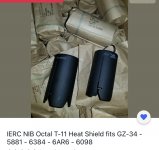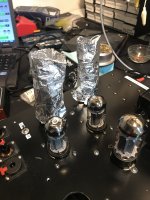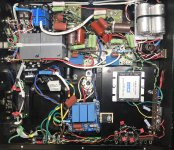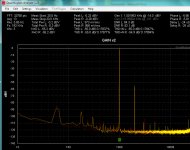So it was interference in the end. Adamus was spot on recognizing it.
Brilliant with the thermos. 😀
Haha yes you did allude to interference didn't you, but it slipped right by me. Yup, Adamus on the money. It does have a characteristic kind of sound. I see people ripping their circuits apart and all ya gotta really do is slap a thermos on it 😀
Haha yes those should work! Lol
Just bought 2 of the attached on eBay for $5 a piece, will report back
Just bought 2 of the attached on eBay for $5 a piece, will report back
Attachments
Last edited:
Winning!!!
I never considered myself a tweaker, but these little gremlins have driven me to the edge. And I think I finally beat them!
Decided to go DC, using just available parts I had on hand. Rigged up a raw DC through some schottkeys. I had about 500mv of ripple that looked like a buzzsaw. Not so great. But I collect odd power electronics modules, and had these Vicor Ripple Attenuators that I've been dying to use on something. Well, the time was now. Got the ripple down to 5mv and running 6.25V to the heaters. And the gain stage is now QUIET QUIET QUIET.
And it sounds effing awesome. Still waiting for proper tube shields on order, so had to do with aluminum foil for now lol.
Anyway, I gained a full 10db of SNR, and totally obliterated that 120Hz peak (see attached measurements).
DONE!
Take that gremlins and wifi router!
Left AC on the CF stage heaters, cause it was quiet anyway and I liked it. But now both stages sound as they should.
If someone can tell me how that vicor module works I would greatly appreciate it. Cap multiplier?
I never considered myself a tweaker, but these little gremlins have driven me to the edge. And I think I finally beat them!
Decided to go DC, using just available parts I had on hand. Rigged up a raw DC through some schottkeys. I had about 500mv of ripple that looked like a buzzsaw. Not so great. But I collect odd power electronics modules, and had these Vicor Ripple Attenuators that I've been dying to use on something. Well, the time was now. Got the ripple down to 5mv and running 6.25V to the heaters. And the gain stage is now QUIET QUIET QUIET.
And it sounds effing awesome. Still waiting for proper tube shields on order, so had to do with aluminum foil for now lol.
Anyway, I gained a full 10db of SNR, and totally obliterated that 120Hz peak (see attached measurements).
DONE!
Take that gremlins and wifi router!
Left AC on the CF stage heaters, cause it was quiet anyway and I liked it. But now both stages sound as they should.
If someone can tell me how that vicor module works I would greatly appreciate it. Cap multiplier?
Attachments
Last edited:
Here's a bit about the attenuator module:
http://www.vicorpower.com/documents/applications_manual/200VIJ00_Sect_15.pdf
http://www.vicorpower.com/documents/applications_manual/200VIJ00_Sect_15.pdf
If someone can tell me how that vicor module works I would greatly appreciate it. Cap multiplier?
They explain it very well in its pdf link. It has both an LC EMI filter and a low frequency active ripple canceller. Sees the ripple and works in anti-phase. It needs some in-out difference. 350mV at least.
Yeah I understand the high level description. But wondered if there are other examples of this ripple attenuation circuit, or what this arrangement/topology could be described as (in terms of circuit description). Are there diy examples here on the forum, or is this more a proprietary and hard to implement scheme. It works really quite well. The 350mv appears to be the amount of voltage dropout between input and output. I've got about 6.6v in and 6.25v out.
Anyway not so important, just curious. You can these units on eBay surplus for like $20 routinely.
Anyway not so important, just curious. You can these units on eBay surplus for like $20 routinely.
Hi Anchan,
That VI-200-E2 looks great, but quite expensive and with more than half a year lead time. I seems shipments to Europe are difficult if not impossible.
Glad this works for you, I’m working on schottky rectifying too, with active 400Khz. step up regulators. I hope to get similar results.
Regards, Gerrit
That VI-200-E2 looks great, but quite expensive and with more than half a year lead time. I seems shipments to Europe are difficult if not impossible.
Glad this works for you, I’m working on schottky rectifying too, with active 400Khz. step up regulators. I hope to get similar results.
Regards, Gerrit
Many on eBay. I never buy that stuff new. I think I paid $20.
Hi Anchan,
That VI-200-E2 looks great, but quite expensive and with more than half a year lead time. I seems shipments to Europe are difficult if not impossible.
Glad this works for you, I’m working on schottky rectifying too, with active 400Khz. step up regulators. I hope to get similar results.
Regards, Gerrit
Hopefully posting a few more incremental improvements is helpful and not overly tedious. Don't mean to wank lol.
But here is the gain version with the heat sinks I bought on ebay which acts as shields. Btw, this is in a commercial building in NYC, with fluorescent lights above me audibly buzzing, and wifi router on and 2m away. so I think this is the max quiet I can get. This time I'm really done! Thanks to all.
But here is the gain version with the heat sinks I bought on ebay which acts as shields. Btw, this is in a commercial building in NYC, with fluorescent lights above me audibly buzzing, and wifi router on and 2m away. so I think this is the max quiet I can get. This time I'm really done! Thanks to all.
Attachments
Not bad at all for 15dB gain. Those shields look nice in black. Do they press enough on the tubes helping with microphonics too?
Look at the inside near the top of the closest shield.
You can see the top fingers of the springs that hug the tubes.
And since the shield cuts off the air from cooling the tube, the finger-stock helps to carry away the heat to the shield.
Flat Black is a good heat radiator.
Because they hug the tube, you do not even need the special sockets that hang onto the shield.
You are not going to have 5 inch or 8 inch gun mounts firing, and vibrating your house, are you?
Then the tubes will not come out of their sockets.
These were quite common in military equipment.
Yes, you need some kind of electrical contact, if you want the electrostatic shielding effect.
You can see the top fingers of the springs that hug the tubes.
And since the shield cuts off the air from cooling the tube, the finger-stock helps to carry away the heat to the shield.
Flat Black is a good heat radiator.
Because they hug the tube, you do not even need the special sockets that hang onto the shield.
You are not going to have 5 inch or 8 inch gun mounts firing, and vibrating your house, are you?
Then the tubes will not come out of their sockets.
These were quite common in military equipment.
Yes, you need some kind of electrical contact, if you want the electrostatic shielding effect.
Last edited:
The tung-sols don't quite fill out the inside. They're pretty lose, but inside the sink are these springy teeth. So I think having just one side in contact with that probably cuts down on at least some of the microphony
Last edited:
- Home
- Amplifiers
- Tubes / Valves
- 6V6 line preamp







